Chemokine - Guides d'étude, Notes de cours & Résumés
Vous recherchez les meilleurs guides d'étude, notes d'étude et résumés sur Chemokine ? Sur cette page, vous trouverez 157 documents pour vous aider à réviser pour Chemokine.
Page 2 sur 157 résultats
Trier par
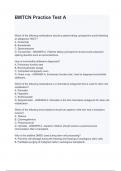
-
BMTCN Practice Test A questions and answers
- Examen • 10 pages • 2024
-
Disponible en pack
-
- €7,80
- + en savoir plus
Which of the following medications should a patient taking cyclosporine avoid following an allogeneic HSCT? A. Torsemide B. Bumetanide C. Spironolactone D. Furosemide - ANSWER-C. Patients taking cyclosporine should avoid potassium sparing diuretics such as spironolactone. How is bronchiolitis obliterans diagnosed? A. Pulmonary function test B. Bronchoalveolar lavage C. Computed tomography scan D. Chest x-ray - ANSWER-A. Pulmonary function test. Used to diagnose bronchiolitis oblitera...
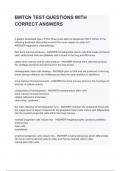
-
BMTCN TEST QUESTIONS WITH CORRECT ANSWERS
- Examen • 61 pages • 2024
-
Disponible en pack
-
- €7,80
- + en savoir plus
A patient developed type 4 PTLD three years after an allogeneic HSCT. Which of the following treatment interventions would the nurse expect an order for? - ANSWER-Aggressive chemotherapy Red bone marrow produces - ANSWER-hematopoietic stems cells that create red blood cells, white blood cells and platelets and is found in the long and flat bones yellow bone marrow and fat cells produce - ANSWER-stromal stem cells that produce fat, cartilage and bone and are found in the long bones. hemato...
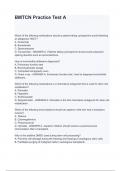
-
BMTCN Practice Test A questions with multiple correct answers
- Examen • 10 pages • 2024
-
Disponible en pack
-
- €7,80
- + en savoir plus
Which of the following medications should a patient taking cyclosporine avoid following an allogeneic HSCT? A. Torsemide B. Bumetanide C. Spironolactone D. Furosemide - ANSWER-C. Patients taking cyclosporine should avoid potassium sparing diuretics such as spironolactone. How is bronchiolitis obliterans diagnosed? A. Pulmonary function test B. Bronchoalveolar lavage C. Computed tomography scan D. Chest x-ray - ANSWER-A. Pulmonary function test. Used to diagnose bronchiolitis oblitera...
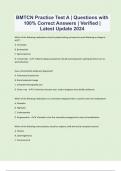
-
BMTCN Practice Test A | Questions with 100% Correct Answers | Verified | Latest Update 2024
- Examen • 12 pages • 2023
-
Disponible en pack
-
- €13,18
- + en savoir plus
Which of the following medications should a patient taking cyclosporine avoid following an allogenic HSCT? A. Torsemide B. Bumetanide C. Spironolactone D. Furosemide - C. Patients taking cyclosporine should avoid potassium sparing diuretics such as spironolactone. How is bronchiolitis obliterans diagnosed? A. Pulmonary function test B. Bronchoalveolar lavage C. Computed tomography scan D. Chest x-ray - A. Pulmonary function test. Used to diagnose bronchiolitis obliterans. Which of th...
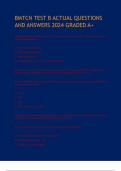
-
BMTCN TEST B ACTUAL QUESTIONS AND ANSWERS 2024 GRADED A+
- Examen • 18 pages • 2024
-
Disponible en pack
-
- €12,69
- + en savoir plus
BMTCN TEST B ACTUAL QUESTIONS AND ANSWERS 2024 GRADED A+ Transplant-related toxicity is a barrier that contributes to the under utilization for which of the following diseases? A. Non-Hodgkin lymphoma B. Acute myeloid leukemia C. Sickle cell disease D. Neuroblastoma Ans- C. Sickle cell disease Despite success of HSCT in sickle cell disease, barriers to successful HSCT include lack of a suitable donor, transplant related toxicity and immunologic graft rejection. Which of the foll...
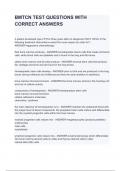
-
BMTCN TEST QUESTIONS WITH CORRECT ANSWERS
- Examen • 61 pages • 2024
-
Disponible en pack
-
- €7,80
- + en savoir plus
A patient developed type 4 PTLD three years after an allogeneic HSCT. Which of the following treatment interventions would the nurse expect an order for? - ANSWER-Aggressive chemotherapy Red bone marrow produces - ANSWER-hematopoietic stems cells that create red blood cells, white blood cells and platelets and is found in the long and flat bones yellow bone marrow and fat cells produce - ANSWER-stromal stem cells that produce fat, cartilage and bone and are found in the long bones. hemato...
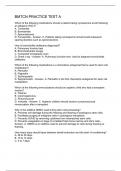
-
BMTCN Practice Test A
- Examen • 9 pages • 2023
-
- €12,20
- + en savoir plus
Which of the following medications should a patient taking cyclosporine avoid following an allogenic HSCT? A. Torsemide B. Bumetanide C. Spironolactone D. Furosemide - Answer- C. Patients taking cyclosporine should avoid potassium sparing diuretics such as spironolactone. How is bronchiolitis obliterans diagnosed? A. Pulmonary function test B. Bronchoalveolar lavage C. Computed tomography scan D. Chest x-ray - Answer- A. Pulmonary function test. Used to diagnose bronchiolitis oblitera...
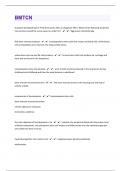
-
BMTCN 618 Questions with 100% Correct Answers | Verified | Latest Update|2024|80 Pages
- Examen • 80 pages • 2024
-
Disponible en pack
-
- €11,22
- + en savoir plus
A patient developed type 4 PTLD three years after an allogeneic HSCT. Which of the following treatment interventions would the nurse expect an order for? - ️️Aggressive chemotherapy Red bone marrow produces - ️️hematopoietic stems cells that create red blood cells, white blood cells and platelets and is found in the long and flat bones yellow bone marrow and fat cells produce - ️️stromal stem cells that produce fat, cartilage and bone and are found in the long bones. hematop...
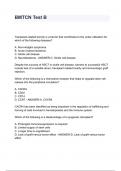
-
BMTCN Test B Questions and answers
- Examen • 16 pages • 2024
-
Disponible en pack
-
- €7,80
- + en savoir plus
BMTCN Test B Transplant-related toxicity is a barrier that contributes to the under utilization for which of the following diseases? A. Non-Hodgkin lymphoma B. Acute myeloid leukemia C. Sickle cell disease D. Neuroblastoma - ANSWER-C. Sickle cell disease Despite the success of HSCT in sickle cell disease, barriers to successful HSCT include lack of a suitable donor, transplant related toxicity and immunologic graft rejection. Which of the following is a chemokine receptor that helps to...
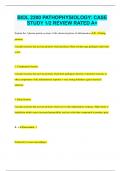
-
BIOL 2200 PATHOPHYSIOLOGY: CASE STUDY 1/2 REVIEW RATED A+
- Examen • 8 pages • 2024
-
Disponible en pack
-
- €9,76
- + en savoir plus
BIOL 2200 PATHOPHYSIOLOGY: CASE STUDY 1/2 REVIEW RATED A+ Explain the 3 plasma protein systems of the chemical portion of inflammation 1. Clotting proteins: Cascade reactions that activate proteins which produces fibrin net that traps pathogens and forms a clot. 2. Complement System: Cascade reactions that activate proteins which kills pathogens directly or intensify reactions of other components of the inflammatory response = very strong defenders against bacterial infection 3. ...

Ce résumé que vous venez d'acheter a fait très plaisir à quelqu'un. Vous voulez aussi être payé chaque semaine ? Vendez vos documents d'étude sur Stuvia ! Découvrez tout sur gagner de l'argent sur Stuvia


